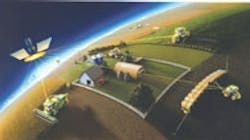Rich Curless knows where machine tool customers are headed: They want an operator to be able to walk up to a machine, push the start button and have that machine make all its own decisions on how to start pumping out the parts automatically.
Curless, who leads R&D and product development for Cincinnati Lamb, Hebron, Ky., says that is the goal of an industry/government coalition on smart machines. Initially spearheaded by the National Institute of Science and Technology, the group has evolved into Smart Machines Coalition. Included are the National Center for Manufacturing Sciences, the National Center for Defense Machining and Manufacturing, and the Association for Manufacturing Technology (AMT).
Machine intelligence is part of an evolutionary process that was well under way by 1970, observes AMT's Paul Warndorf, vice president, technology. He's referring to how punched-tape numerical control (NC) -- which originated in the mid-'50s was transitioning to computer NC in the 1970s. Instead of the NC machine being controlled by a punched paper tape, the source of the control directives evolved to be a computer hard drive. Another epochal event was the innovation of the programmable logic controller by Dick Morley to replace relay logic, says Warndorf.
Also, globalization and multi-tasking machines remade the course of machine tool history during the 1970s and 1980s, notes Cincinnati Lamb's Dan D. Janka, president. "With the multi-tasking concept, one setup on one machine could do the work that required three setups on three machines," Janka says. The emerging presence of Japanese firms such as Mazak and Mori Seiki signaled the globalization of the U.S. machine tool market.
Radio frequency technology is the emerging next step for both agricultural and industrial equipment. For example on the farm, global positioning technology can be used to help steer tractors to more accurately till and spread agricultural chemicals. John Deere claims satellite guidance can hold overlaps to 4 inches -- even better with special equipment. (Without guidance equipment, wasteful overlaps with a 60-foot tool can be as large as 6 feet, John Deere says.)
In the industrial machinery sector, radio frequency technology has progressed to the point where companies use RFID (radio-frequency identification) to identify production equipment as well as products. Other instances include wireless machine control pendants, Warndorf says.
A solution emphasis is the big shift that is increasingly profiting industrial equipment marketers, says Davidson, N.C.-based Edward L. Doheny, vice president, Ingersoll-Rand and president, Ingersoll-Rand Industrial Solutions. He says the gains go beyond strengthening the customer connection. "Equipment vendors continue to discover that solution selling is the best way to refine a product roster for greater customer value," Doheny says.
